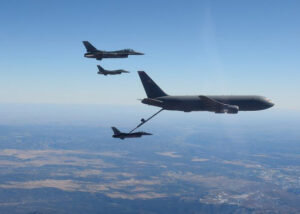The Air Force is flying the Boeing [BA] KC-46 tanker and conducting fueling in exercises for some aircraft to build crew capability while awaiting remaining fixes to several key deficiencies, a top official said March 31.
In 2020, the Air Force identified six Category I, or critical,
deficiencies with the KC-46A. The service said it is working with Boeing to plan fixes, including a new Remote Vision System (RVS) 2.0. The RVS 2.0 aims to allow air refueling operator station personnel to steer the refueling booms using Collins Aerospace [RTX] cameras on the fuselage (Defense Daily, Oct. 27, 2020).

“We have four open category one deficiencies on the KC-46. Two of them are boom-related and then one is work that we’re doing on a manifold which we have a solution for and are working toward cleaning that up and getting that retrofit onto the airplane. We’ve seen great progress in the last year at getting after the deficiency reports on the airplane,” Air Force Gen. Jacqueline Van Ovost, commander of Air Mobility Command (AMC), said during a Mitchell Institute webinar event Wednesday.
In February, Van Ovost said the Air Force resolved two of the six deficiencies related to the Auxiliary Power Unit and component pieces (Defense Daily, Feb. 1).
With most of the remaining deficiencies involving the RVS, on Wednesday she said the service is working closely with Boeing on the new boom vision system and could see some fixes tested in the near term.
“Actually we are…pretty close in now to slap the table on the actual design and we’re hoping to see some hardware airborne inside a year.”
Van Ovost continued that AMC is now doing some interim capability releases on the aircraft.
“In other words we are working toward flying the airplane on task lines for U.S. Transportation Command within the current restrictions that we have on the airplane…we cannot go to full operational capability for the airplane just yet, but we can do some things and what we’re doing is maximizing our capacity to do so.”
She said the Air Force is sending the KC-46 out to do fighter drags. It is fully cleared to do drogue refueling, which is mostly Navy refueling, and “we have been fueling F-16s in exercises and red flags and we’ve done some dragging overseas.”
Last month, Van Ovost told reporters the service was exploring options to relieve stress on the current tanker force, including operational use of the KC-46 on a conditions-based approach. That would allow the KC-46 to accept operational taskings from Transportation Command otherwise filled by KC-135s and KC-10s (Defense Daily, Feb. 24).
Van Ovost noted while the Air Force has not deployed the aircraft, “our crews are becoming more capable and more confident in the system and the limitations that it has right now.”
She underscored the KC-46 flying they are doing now “will in no way slow down our resolving of the deficiencies, which mainly reside in the boom itself, in the boom vision system itself.”
In February, Van Ovost said the first three deficiencies are the main factors preventing the aircraft from reaching full operational capability. Full capability will have to wait until RVS 2.0 and the new boom telescope actuator device are released.
Last June, the Air Force said it pushed back the KC-46 timeline for Initial Operational Test and Evaluation and delayed a full-rate production decision until at least fiscal year 2024 (Defense Daily, June 10, 2020).
In her February comments, Van Ovost said RVS 2.0 and the boom telescope actuator fixes will be ready by fiscal year 2024 and the AMC still plans to have 179 KC-46s in the inventory by 2029.
Boeing has thus far delivered 42 KC-46s to four Air Force bases: McConnell AFB, Kan.; Altus AFB, Okla.; Pease Air National Guard Base, N.H.; and Seymour Johnson AFB, N.C.